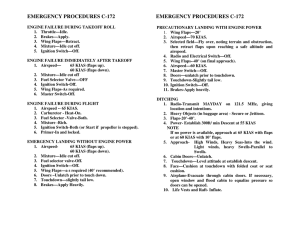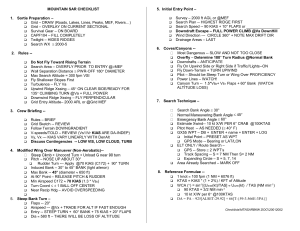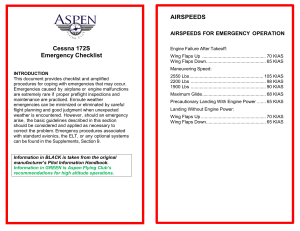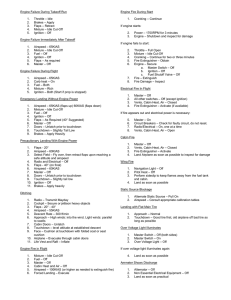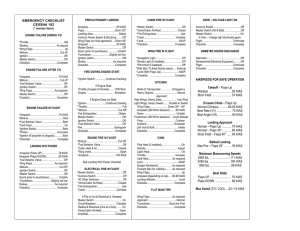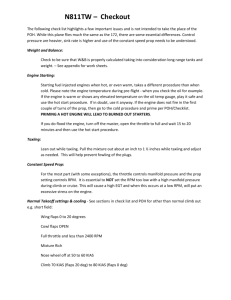Emergency Procedures
advertisement
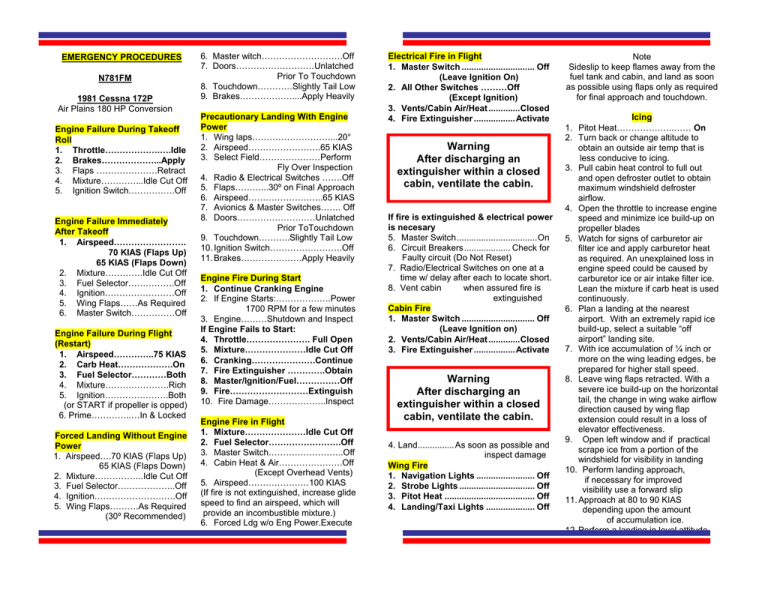
EMERGENCY PROCEDURES N781FM 1981 Cessna 172P Air Plains 180 HP Conversion Engine Failure During Takeoff Roll 1. Throttle……………….….Idle 2. Brakes………………...Apply 3. Flaps …………………Retract 4. Mixture…………...Idle Cut Off 5. Ignition Switch…………….Off Engine Failure Immediately After Takeoff 1. Airspeed……………………. 70 KIAS (Flaps Up) 65 KIAS (Flaps Down) 2. Mixture………….Idle Cut Off 3. Fuel Selector…………….Off 4. Ignition……………………Off 5. Wing Flaps……As Required 6. Master Switch……………Off Engine Failure During Flight (Restart) 1. Airspeed…………..75 KIAS 2. Carb Heat……………….On 3. Fuel Selector…………Both 4. Mixture………………….Rich 5. Ignition………………….Both (or START if propeller is opped) 6. Prime…………..…In & Locked Forced Landing Without Engine Power 1. Airspeed….70 KIAS (Flaps Up) 65 KIAS (Flaps Down) 2. Mixture……………..Idle Cut Off 3. Fuel Selector………………..Off 4. Ignition……………………….Off 5. Wing Flaps……….As Required (30º Recommended) 6. Master witch……………………….Off 7. Doors………………………Unlatched Prior To Touchdown 8. Touchdown…………Slightly Tail Low 9. Brakes………………....Apply Heavily Precautionary Landing With Engine Power 1. Wing laps………………………...20° 2. Airspeed…………………….65 KIAS 3. Select Field…………………Perform Fly Over Inspection 4. Radio & Electrical Switches …….Off 5. Flaps………...30º on Final Approach 6. Airspeed……………………..65 KIAS 7. Avionics & Master Switches……. Off 8. Doors………………………Unlatched Prior ToTouchdown 9. Touchdown………..Slightly Tail Low 10. Ignition Switch…………………….Off 11. Brakes…………………Apply Heavily Engine Fire During Start 1. Continue Cranking Engine 2. If Engine Starts:……………….Power 1700 RPM for a few minutes 3. Engine………Shutdown and Inspect If Engine Fails to Start: 4. Throttle…………………. Full Open 5. Mixture…………………Idle Cut Off 6. Cranking………………….Continue 7. Fire Extinguisher ………….Obtain 8. Master/Ignition/Fuel……………Off 9. Fire………………………Extinguish 10. Fire Damage………………..Inspect Engine Fire in Flight 1. Mixture…………………Idle Cut Off 2. Fuel Selector…………………….Off 3. Master Switch……………………..Off 4. Cabin Heat & Air………………….Off (Except Overhead Vents) 5. Airspeed…………………100 KIAS (If fire is not extinguished, increase glide speed to find an airspeed, which will provide an incombustible mixture.) 6. Forced Ldg w/o Eng Power.Execute Electrical Fire in Flight 1. Master Switch .............................. Off (Leave Ignition On) 2. All Other Switches ………Off (Except Ignition) 3. Vents/Cabin Air/Heat .............Closed 4. Fire Extinguisher .................Activate Warning After discharging an extinguisher within a closed cabin, ventilate the cabin. If fire is extinguished & electrical power is necesary 5. Master Switch.................................On 6. Circuit Breakers................... Check for Faulty circuit (Do Not Reset) 7. Radio/Electrical Switches on one at a time w/ delay after each to locate short. 8. Vent cabin when assured fire is extinguished Cabin Fire 1. Master Switch .............................. Off (Leave Ignition on) 2. Vents/Cabin Air/Heat .............Closed 3. Fire Extinguisher .................Activate Warning After discharging an extinguisher within a closed cabin, ventilate the cabin. 4. Land............... As soon as possible and inspect damage Wing Fire 1. Navigation Lights ........................ Off 2. Strobe Lights ............................... Off 3. Pitot Heat ..................................... Off 4. Landing/Taxi Lights .................... Off Note Sideslip to keep flames away from the fuel tank and cabin, and land as soon as possible using flaps only as required for final approach and touchdown. Icing 1. Pitot Heat………………..…… On 2. Turn back or change altitude to obtain an outside air temp that is less conducive to icing. 3. Pull cabin heat control to full out and open defroster outlet to obtain maximum windshield defroster airflow. 4. Open the throttle to increase engine speed and minimize ice build-up on propeller blades 5. Watch for signs of carburetor air filter ice and apply carburetor heat as required. An unexplained loss in engine speed could be caused by carburetor ice or air intake filter ice. Lean the mixture if carb heat is used continuously. 6. Plan a landing at the nearest airport. With an extremely rapid ice build-up, select a suitable “off airport” landing site. 7. With ice accumulation of ¼ inch or more on the wing leading edges, be prepared for higher stall speed. 8. Leave wing flaps retracted. With a severe ice build-up on the horizontal tail, the change in wing wake airflow direction caused by wing flap extension could result in a loss of elevator effectiveness. 9. Open left window and if practical scrape ice from a portion of the windshield for visibility in landing 10. Perform landing approach, if necessary for improved visibility use a forward slip 11. Approach at 80 to 90 KIAS depending upon the amount of accumulation ice. 12. Perform a landing in level attitude. Ditching 1. Radio………..Transmit Mayday on 121.5 giving location and intentions and squawk 7700 2. Heavy objects………...…...Secure or Jettison 3. Flaps…………………….20º to 30º 4. Power…………….Est. a 300 FPM descent at 55 KIAS 5. Approach …………High winds, heavy seas Into the Wind Light winds, heavy swells………. Parallel to swells Note If no power is available, approach at 70 KIAS with flaps up or at 65 KIAS with 10º flaps. 6. Cabin Doors………………Unlatch 7. Touchdown…………Level attitude at established descent rate 8. Face………Cushion at touchdown with folded coat or seat cushion. 9. Airplane……….Evacuate through Cabin doors. If necessary, open window and flood cabin to equalize pressure so doors can be opened. 10. Life vests and raft………..Inflate Airspeeds for Emergency Operations LANDING WITHOUT ELEVATOR CONTROL Trim for horizontal flight (with an airSpeed of approximately 65 KIAS and Flaps set to 20 deg.) by using throttle And elevator trim controls. Then DO NOT change the elevator trim control setting; control the glide angle by adjusting power exclusively. Engine Failure After Takeoff: Wing Flaps Up ------ 70 KIAS Wing Flaps Down – 65 KIAS Maneuvering Speed: 2550 Lbs –105 KIAS 2150 Lbs –- 95 KIAS 1750 Lbs -- 85 KIAS Maximum Glide: 2550 Lbs – 65 KIAS 2150 Lbs – 62 KIAS 1750 Lbs – 56 KIAS Precautionary Landing With Engine Power – 65 KIAS At flareout, the nose-down moment Resulting from power reduction is an Adverse factor and the airplane may hit On the nose wheel. Consequently, at Flareout, the elevator trim control should be adjusted toward the full noseUp position and the power adjusted so that the airplane will rotate to the horiZontal attitude for touchdown. Close the throttle at touchdown This checklist is a guide to coordinate Landing Without Engine Power: Pilot Operating Handbook and STC data Wing Flaps Up – 70 KIAS applicable to this particular aircraft only. Wing Flaps Down – 65 KIAS The applicable Pilot Operating Handbook and STC installations remain the official documentation for this aircraft. The pilot in command is responsible for complying with all items in the Pilot Operating Handbook and applicable STCs. I certify this checklist has been reviewed for accuracy. For all other Emergency Abnormal Procedures. See the POH Section 3. ________________________1/1/06__ Director of Maintenance Date
